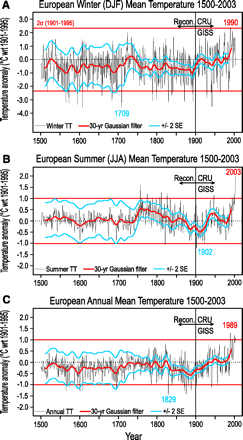There’s a new set of long-term climate change data out, this one for Europe over the last 500 years, and once again it’s shaped like a hockey stick:

The authors, J?rg Luterbacher from the University of Bern and colleagues, in today’s Science (sub. req.), have nailed down a proxy record that allows them to tease out seasonal variability in European temperature, rather than the usual annual numbers you see in some of the broader proxy records.
This is incredibly important for the research enterprise, where comparisons between the computer models and empirical record are critical for understanding the nature and extent of both natural and anthropogenic climate change. But the Luterbacher paper also ought to be relevant for the political debates over climate change, especially the argument triggered by last fall’s reanalysis of Mann et. al.’s famous “hockey stick” by Stephen McIntyre and Ross McKitrick.
The Mann et. al. hockey stick is based on a paper Michael Mann and his colleagues published in Nature in 1998, which uses a millennium of climate proxies to argue that the last century’s warming is unprecedented over the time scale under study. It’s become iconic in the global warming debate, which makes it ripe for skeptics’ attacks, which is what McIntyre and McKitrick did. Their reanalysis of Mann’s data yielded the claim that the original hockey stick had a big upward bend in the middle that Mann and his colleagues missed, and that the 1500s were every bit as warm as things are today. If true, that would blast a hole in the claim that greenhouse gases are creating unprecedented global warming.
I’ve always thought that the M&M argument was something of a straw man, by setting up the original hockey stick as the thing to knock down, and arguing that they’ve therefore knocked the legs out from under the antropogenic warming argument. Even if one grants that their analysis is correct (a questionable assertion – Mann et. al. have argued that M&M left out some of the original data, biasing the result, and that argument remains unsettled), the new analysis ignores a host of confirmatory data, using other proxies, that shows the same sort of hockey stick. As Mann pointed out in a 2002 review paper (sub. req.), four other proxy records published since all look like hockey sticks too.
The search for confirmation, it seems, has been successful, and if M&M are to have any scientific impact (as opposed to political impact, which they’ve already had), they need to reach deeper and provide a more fundamental explanation of why all the published proxies are wrong. You can’t just knock down Mann et. al.’s hockey stick. You’ve got to tackle them all.
That is the significance, in terms of the ongoing political debate, of the new Luterbacher paper. One more proxy data set, one more hockey stick. In terms of the science, the new paper, by providing seasonal resolution, gives the modelers a great new set of data against which to compare the results their computers spew out.

I fully expect the Marshall/Heritage/AEI/CEI – Tech Central Station axis to immediately begin a smear campaign and to sic Soon and Baliunas or McKitrick on this piece – there should be a debunking in Energy and Environment soon.
D
Pingback: jfleck at inkstain » Blog Archive » In Which I Utterly, Completely, and For the Last Time (I Promise, Really) Swear Off All Participation in the Hockey Wars